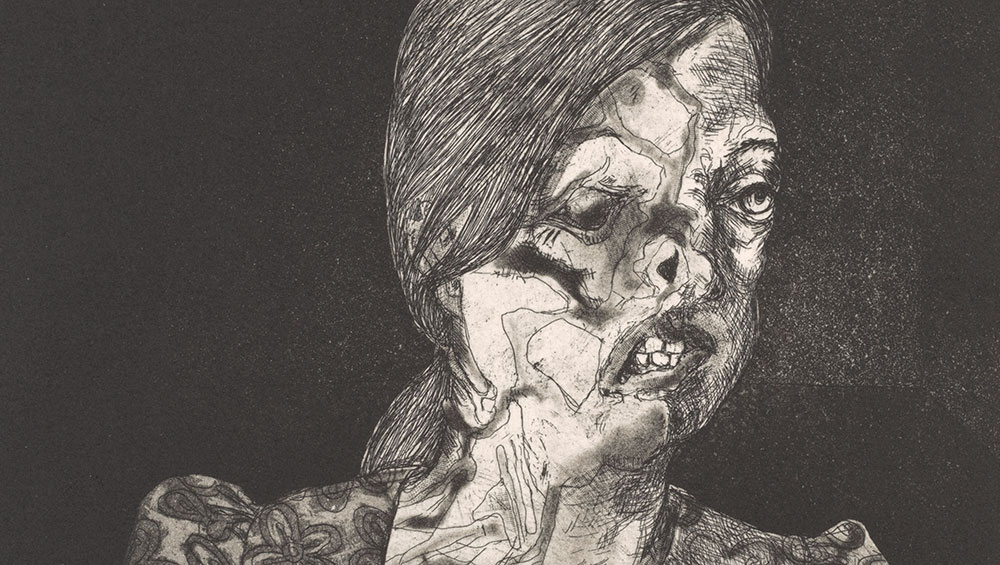
Marcelle Hanselaar, They threw acid in her face, 2015 (detail). Etching and aquatint. No.6 from the set The Crying Game. © Marcelle Hanselaar.
by ANNA McNAY
Marcelle Hanselaar (b1945, Rotterdam) is a painter and a printmaker, whose subject, broadly speaking, is humanity. Her unsettling and often foreboding works pare back humanity (that is, humankind) to its most exposed and raw of states, where nearly all humanity (that is, humaneness) is lost. She depicts death, violence, war, bloodiness and torture – all from the standpoint that these things go on regardless, and that, besides having a duty to acknowledge this, it is better to become acquainted with our own dark sides, since our lives could be turned upside down at any minute, as they have been for the millions caught up in civil wars around the globe.
The Crying Game, a series of 30 prints, was made in 2015 (1-20) and 2017 (21-30), with each plate combining a different etching technique. With each image confronting the viewer with a different atrocity, from sex slavery to drug addiction, child soldiers to acid attacks, and knife crime to FGM, these are not easy works to view, but they speak the unflinching truth. By using her deep feeling and theatrical imagination to ask herself how she would feel and respond in such circumstances, Hanselaar produces images at once horrendous and empathetic.
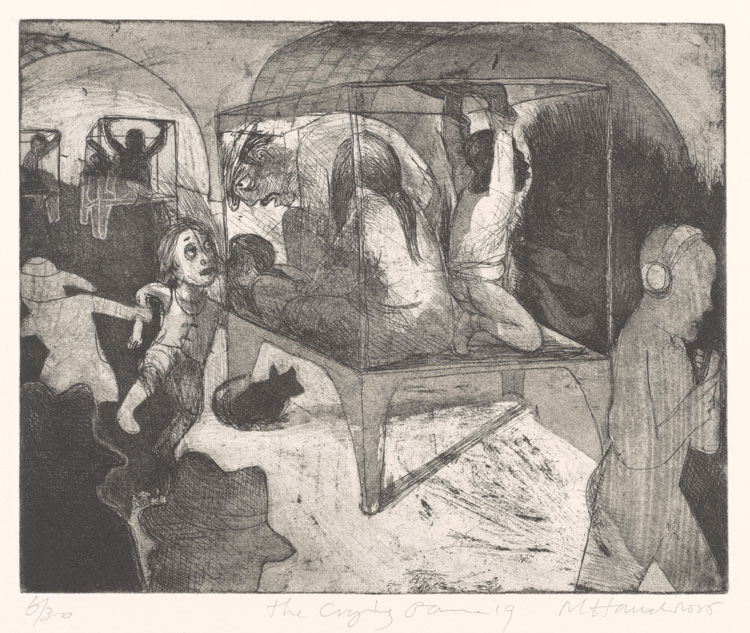
Marcelle Hanselaar, Stuck, 2015. Etching and aquatint. No.19 from the set The Crying Game. © Marcelle Hanselaar.
With the recent acquisition of 20 of the prints for its collection, the Fitzwilliam Museum has put together a small but impactful display, Bearing Witness? Violence and Trauma on Paper, situating Hanselaar in a lineage of printmakers who deal with these hard-hitting subjects. Her works sit alongside those of Picasso, Goya, the Chapman Brothers and Käthe Kollwitz, among others.
Studio International spoke to Hanselaar, at the Fitzwilliam, to find out more about her approach to making work on such difficult subjects, and why her preferred medium for this is etching.
Anna McNay: This exhibition is focused on trauma and violence, and I know these are threads that run through much of your work. Would you consider them to be the main themes in your work, and would it be the same for your printmaking and painting?
Marcelle Hanselaar: I think the printmaking is a little bit more specific because it is quite a rebellious medium, a little bit more confrontational. The medium, with the biting of nitrate into metal, has quite a harsh nature. Also, a lot of my work has concerned itself with power, the struggle of power we have within ourselves. We always want to be more powerful than the next person: bigger, taller, more famous, more whatever. Equality is a very difficult concept. Power struggles go on all the time. They don’t have to be nasty, they are just going on all day, 24/7. It is important to recognise them, because, when they are not checked, they can lead to excessive forms of violence, trauma, subjugation, religious suppression, gender suppression, etc. People become more primitive and lash out with fewer restraints. I think it’s really that awareness that is so important, to not let it get out of hand.
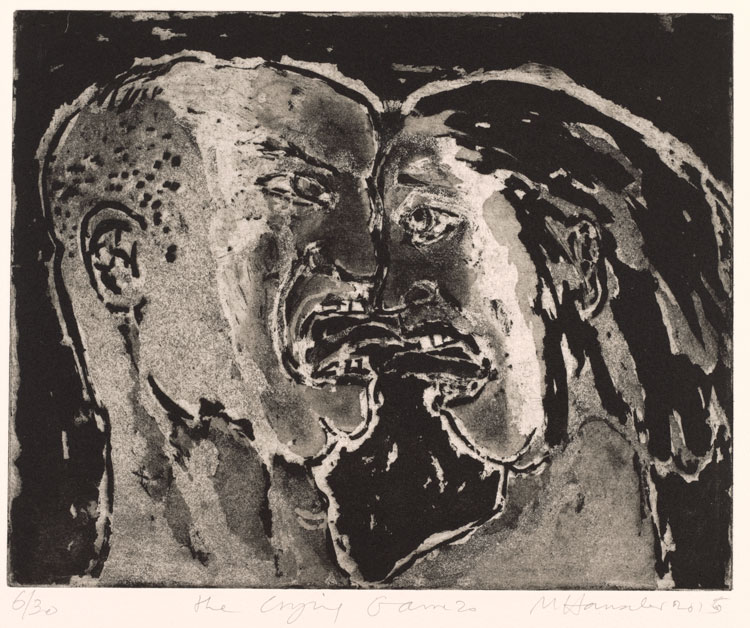
Marcelle Hanselaar, Warring Couple, 2015. Sugar-lift aquatint. No.20 from the set The Crying Game. © Marcelle Hanselaar.
AMc: Do you think trauma and violence always go hand in hand?
MH: Yes. I think violence leads to trauma. To be honest, I haven’t experienced a lot of violence myself – at least, not excessively. I don’t think it’s always like that, but, for example, if you have spent a long time living in traumatic circumstances, your response might be to lash out violently instead of something more considered.
AMc: You say you haven’t really experienced much violence yourself, and you are not using your own experience as your subject matter here, you are working from newspaper imagery.
MH: Yes, and “my experience” in this sense is one of empathetic frustration. I hear or read about these terrible things, but I know I cannot change them. Nonetheless, I feel that to do nothing, to not at least take the responsibility of bearing witness, to show no empathy, would be to lose part of our humanity. So, I do experience these things, but in a secondhand way, with the luxury of empathy, instead of being confronted full blast by the experience.
AMc: Looking at your works in the exhibition, alongside those by artists who maybe have experienced things first-hand, I can truthfully say that yours are every bit as impactful.
MH: I think empathy is very strong. Let’s say a friend says, “I have this really terrible pain,” and you can feel that pain yourself. You don’t have that pain, but you can feel it because you’re very close to that friend. That kind of empathetic feeling, although it’s only temporary, can be as intense and as real as the actual feeling. That’s what I think artists, writers, film-makers and so on, work with.
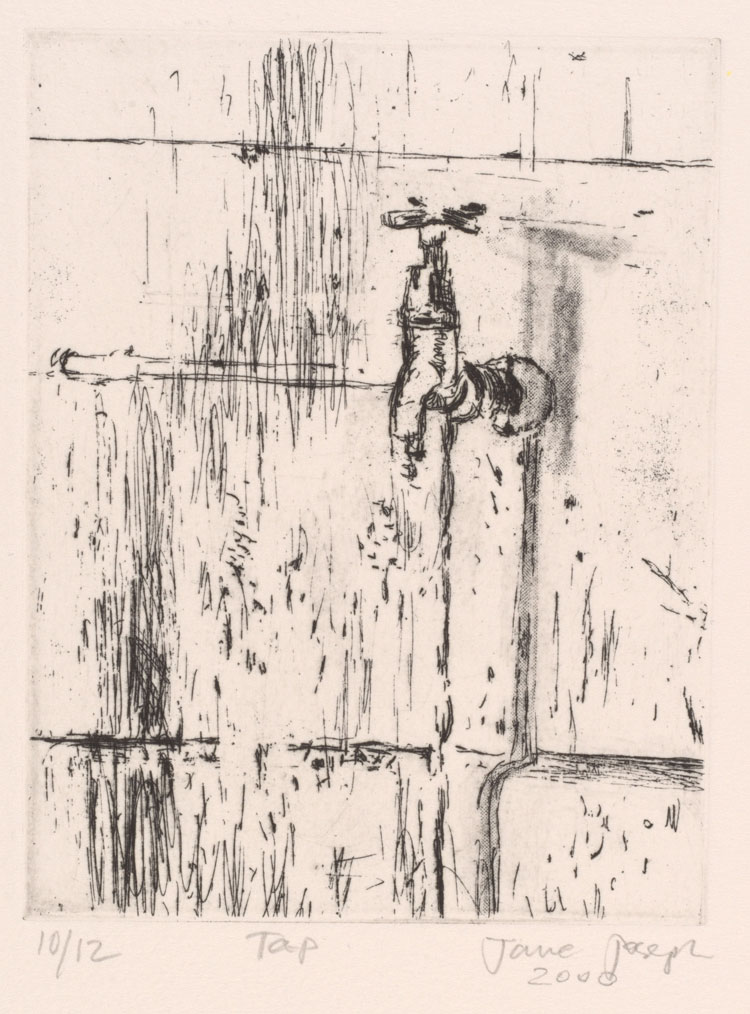
Jane Joseph, Tap, 2000. Etching. From If this is a man portfolio of 12 prints. Given by Craig Hartley in memory of his father Cyril Hartley, 2003. © Jane Joseph.
AMc: Quite a few of the other artists were responding to writing or had their imagery put alongside writing.
MH: Yes, like Jane Joseph, for example. And Goya, who, of course, experienced war.
AMc: And Picasso?
MH: I’m not sure that he experienced war first-hand. But look at the painting he made, Guernica, which is so powerful. In an emotive way, he was there. You place yourself in that situation with the power of imagination. It’s not always easy, you have to walk around with this terrible frustration and pain without being able to do anything. You can just make drawings about it.
AMc: I suppose, if you think of war artists, they don’t necessarily depict the trauma so much as the concrete things that are going on in everyday life.
MH: Yes. Paul Nash did wonderful pictures of the graveyards of aeroplane parts, very evocative. In a way, they transform a reality, or a photographic reality, into something secondary, and, because that imagination is added or allowed in, it can be even more powerful. If you were really in the midst of that kind of violence, you wouldn’t have any perspective. You would be so frozen with fear, trying to think of an escape route. You wouldn’t stop to think: “This is how it looks,” or “What a beautiful sight.” It is really that perspective of being one step removed that I think urges people to become aware, or to remain aware, of what is happening, without drowning in it. Therefore, I think exhibitions like this one have a real importance.
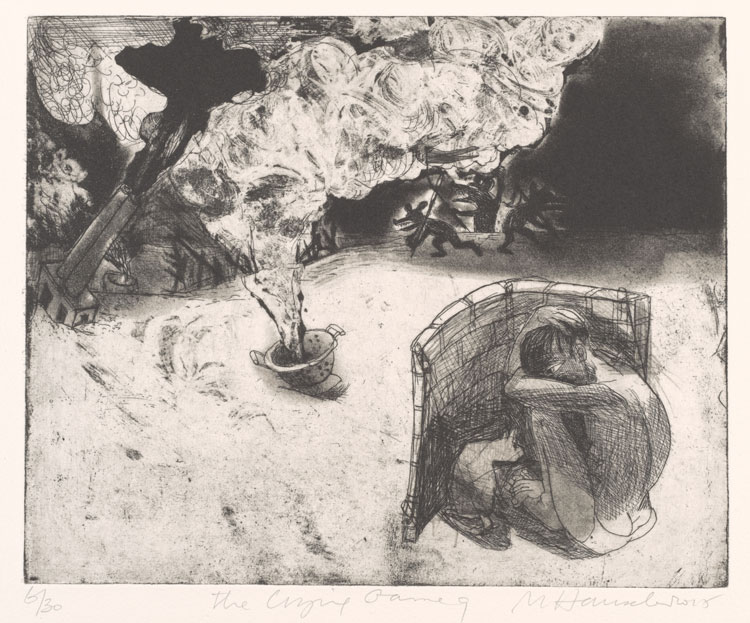
Marcelle Hanselaar, Our last resort, 2015. Etching and aquatint. No.9 from the set The Crying Game. © Marcelle Hanselaar.
AMc: Absolutely. And this exhibition is particularly striking because it covers such a timescale, with so many different places and people, and yet it all comes down to the same underlying violence and trauma.
MH: Exactly. The works are by artists of different nationalities, from different backgrounds, different times, different genders. It really is quite interesting. It could have been a much bigger exhibition had it had the space.
AMc: It could have been all different mediums as well.
MH: Exactly. But etching and graphics have a particular directness about them, which I think is very telling. There is a glorification to painting, even if you’re showing a horse cut in half, dying. Think of Rubens. There is a beauty to the dying bodies, a particular kind of romantic drama, which isn’t there with printmaking.
AMc: Do you think, as a society, we are becoming numb towards images of trauma and violence because we see them so frequently on the television?
MH: Yes, and that was really the incentive that catapulted me into doing something about it. I can’t bear looking at a terrible image, while eating my breakfast in a safe place. I’m very grateful that I’m in a safe place, and that I’m eating breakfast, but, at the same time, when I hear about these things, I can’t just say: “It’s not happening to me, it’s not happening to anybody I know, it’s none of my business.” It may not be my business, but there is a collective carrying of these things that is necessary to show that we don’t not care if the world falls apart around us, as long as we are safe. I think we can be numbed by too many millisecond-long images, so that it becomes fun, or titillation, in a way: the gorier, the more extreme, the better. There are a whole lot of things on the dark web, and I don’t just mean of a sexual nature, but violence, too. I haven’t seen them, but, if I’m honest, I’m curious to know what’s going on. But I’m not going there.
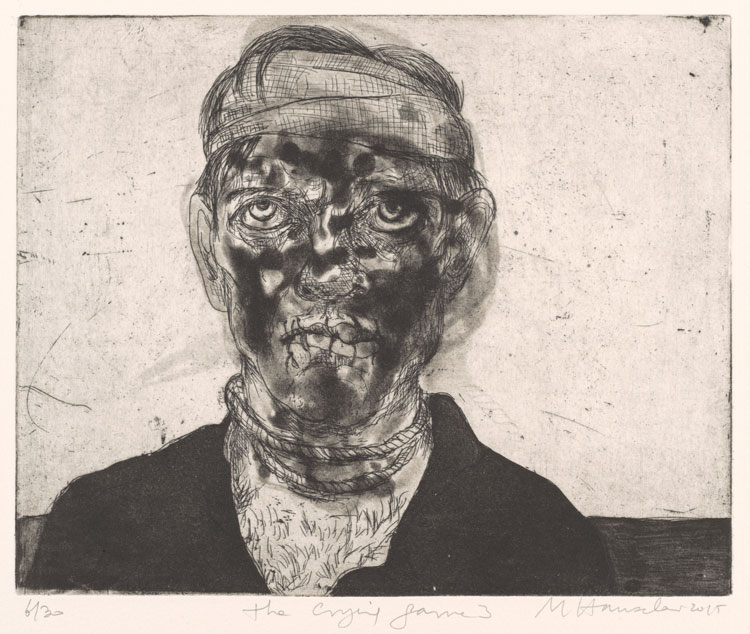
Marcelle Hanselaar, He had nothing more to say, 2015. Etching and aquatint. No.3 from the set The Crying Game. © Marcelle Hanselaar.
AMc: How did you feel when you were making these works?
MH: I made the first 20 images over a period of about seven or eight months, several at a time, because often, when I get into a certain mindset, one work develops into another on the same theme. That’s why I often work in series. But it also means you have to carry that state of being all the time, even when you aren’t working, so it’s quite punishing and exhausting. Two years later, I took it up again, partly because I wanted to make a book, in order to offer a more accessible way for people to see the work, be informed, and have a discussion about it. My publisher, Julian, said: “You can’t make a book about something you have already done, you have to do it again.” It was interesting because the subject matter was slightly different at this time. It was 2017, and a lot of refugees were drowning on their way to “a better future”. So, these final 10 prints have a slightly different focus, but I think all 30 go well together. The Ashmolean has bought the whole set of 30, the Met has bought the whole set, Aberystwyth has bought the whole set; the Fitzwilliam is the only museum to just have 20, but I’m happy because Elenor [Ling, senior curator prints and drawings] says they really fit in the museum’s collection, which includes a fair bit of Dutch printmaking.
AMc: Did you have anything to do with the curating of this display, or was it all down to Elenor?
MH: No, I didn’t. I rarely curate my own exhibitions because I like to be surprised by what people do with my work. It was an extra nice surprise this time because the exhibition was originally planned for 2019.
AMc: Pre-Covid and pre-Ukraine, then.
MH: Yes, that’s the sad thing. It’s all still very relevant. The sex trade, gratuitous violence, destruction by drugs – nothing has changed, and I don’t think it ever will. As a people, we must not be complacent about it.
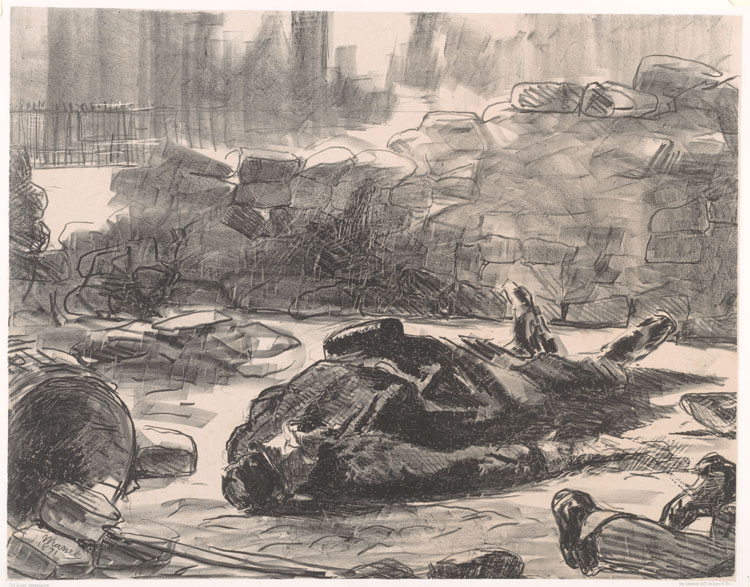
Edouard Manet, Guerre civile (Civil War), 1871–73. Lithograph on chine collé on paper, published 1874. Given by Jeremy Rutenberg through Cambridge in America, 2022. © The Fitzwilliam Museum, Cambridge.
AMc: Are there any artists in the exhibition who particularly inspire you?
MH: For me, at least when it comes to etching, the greatest printmakers are Picasso, Goya and Otto Dix. What they did, technically and in terms of imagery, is totally unsurpassed and an everlasting source of reference. They’re great for giving you ideas. They have a very casual skill, or it looks very casual. I think it’s really important that you don’t look at an image and see how skilful it is. I have seen some Japanese etchings, and they are awesome, but I can see the difficulty of what the artists have done, and I shouldn’t see this; I should see the image, not the workings of it. It’s like if you saw a beautiful person and could see: “There’s a bit of tuck here and a bit of filler there.” You don’t want to see that, do you?
Anyhow, to have two of those stars in the exhibition [Picasso and Goya], and in the dialogue, is wonderful. My one regret is that we were trying to get a Dix, too, but, in the end, it fell through because the paperwork couldn’t be done in time. I’m very disappointed about that. I also would have liked a few more German printmakers from the beginning of the 1900s. But this kind of exhibition is also about the host museum’s own collection, and I think the Fitzwilliam has done something brilliant within its means. The museum has a collection of beautiful work, but then, within that, it has its print collection, which is a collection of beautiful work, which has a bit more meat to it. Historically, print is a medium that has been used to provoke and incite protest, and it is a non-commercial venture, in a way. If you make a pastoral image of a cow grazing, you will have a bigger market for it. These prints are not just pretty pictures to decorate your walls with. Some of them are pretty, but the subject is not that decorative. I think it’s courageous and unusual for a museum to host something like this, and it is very exciting to see.
AMc: One work I found particularly powerful was from Jake and Dinos Chapman’s Disasters of War (1999) series. It is white ink on black paper and incredibly haunting and ghostly.
MH: I was really interested in that one as well. I don’t like some of their installation works, because they do all that Nazi stuff, which is a bit gratuitous, but I think they’re very good printmakers. I also like the fact that they work with existing things [this series is based on Goya’s of the same title, 1810-20], take them one stage further and make them their own. Everybody does it. Picasso went back to Rembrandt. Everybody goes back to someone else, and there is something incredibly inspiring in this hop-skip-and-a-jump continuation from artist to artist.
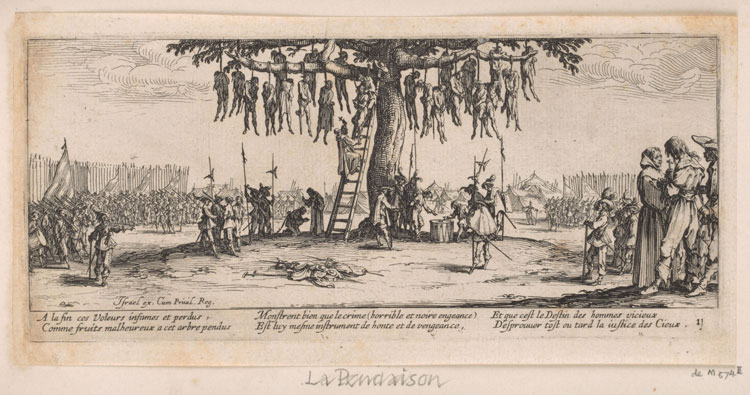
Jacques Callot, The Hangman’s Tree from the set Les Miseres et les Mal-Heurs de la Guerre (Miseries and Misfortunes of the War), 1633, etching. Bequeathed by Charles Brinsley Marlay, 1912. © The Fitzwilliam Museum, Cambridge.
AMc: Can you say something about the title of your series, The Crying Game?
MH: Yes, well, it’s not an original title. I had seen the film The Crying Game, and it just popped into my head when I had finished the first 20 prints and I was wondering what to name them. I often take titles from music, books, or even graffiti I see in town. It needs to have a certain rhythm. In this case, I thought: “Yeah, this is a really good umbrella to cover the expansive subject matter.” I appropriated it for the purpose.
AMc: The individual prints are untitled in the exhibition, but they have titles in the book.
MH: Yes. The prints themselves just have numbers, but I decided to give them individual titles, which indicate their subject matter, for the book. For me, the subject matter was obvious, but I thought I might need to give a bit of a pointer for other people.
AMc: Does each print relate to a specific event?
MH: Yes, each print has its own specific story. The first one, His Calculations Were All Wrong, where the woman is protecting the child from seeing the violence, and there is a naked man sitting with his head in his hands and an abacus in front of him, is about civil war. I’m much more interested in civil war than wars where it’s all about soldiers fighting in armies. I think a lot more about ordinary people, who are caught up in a situation, where they have to defend themselves or flee, and then the responses to this: you’re desperate, you’re a coward, you’re a hero ... This was my theatrical imagining of the dilemma of finding myself sitting there, around the kitchen table, chatting, when the door gets kicked in, and a group of people walks in with guns to shoot us because we are the wrong kind of whatever, according to their ideology. In that moment, everything will change for us, and all our peaceful philosophical statements and claims that we would never do this, that or the other, get dropped. I’m not saying we can ever prepare for this, but I think the only way we can even slightly prepare ourselves is to get to know, or be aware of, our own dark side, in order that it doesn’t completely overwhelm us.
AMc: I was struck by how, in that first print, and also a few of the others, the mother is shielding the child from seeing what is happening, and the man, too, is cowering and looking away, yet the title of the exhibition is Bearing Witness (albeit with a question mark).
MH: The woman stops the child from looking because he is too young. In most of my images, I include something, either an object or another person or an animal, to somehow soften it, or to protect. ln the second print, for example, there is a girl dancing, oblivious of the terrible thing happening between the two men, the torturer and his victim. I often include a dog, a colander, or something, that softens the image, reminding people that what is depicted isn’t taking place in any extreme set of circumstances, it is taking place in the midst of what was normal, daily life.
• Bearing Witness? Violence and Trauma on Paper is at the Fitzwilliam Museum, Cambridge, until 2 April 2023.
Click on the pictures below to enlarge